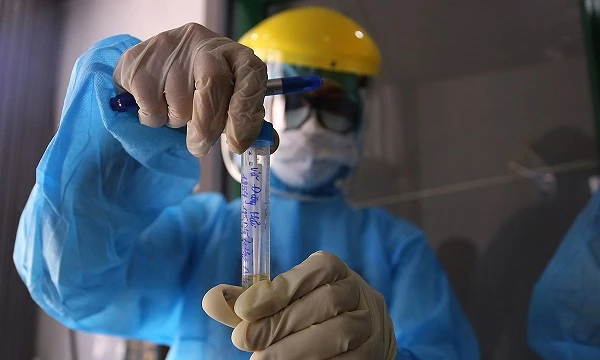How historical precedents hindered the acceptance of airborne COVID-19 transmission
What makes the human brain different? Study reveals clues / The oldest two-legged dinosaur ever discovered in Africa was found in Zimbabwe
The authors trace this lethal resistance back a century to the rejection of unhealthy air referred to as "miasma," the rise of germ theory, and our own stubborn propensity to maintain beliefs despite mounting evidence to the contrary.
In 2020, while the SARS-CoV-2 virus was invisibly infecting people through the air in hospitals, churches, workplaces, and restaurants, people focused on disinfecting surfaces and washing their hands. According to Jose-Luis Jimenez, lead author of a new comprehensive historical assessment of major medical errors involving disease transmission, recently published in the journal Indoor Air, many governments and businesses installed plexiglass barriers that actually increased the spread of coronavirus.
"History set us up for a poor response to the pandemic," said Jimenez, fellow at the Cooperative Institute for Research in Environmental Sciences (CIRES) and distinguished professor of chemistry at CU Boulder. If we had taken appropriate, effective action from the beginning, millions of deaths and hundreds of millions of cases could have been avoided.

How historical precedents hindered the acceptance of airborne COVID-19 transmission (Illustrative image).
The overview, authored with colleagues from ten countries, illuminates the often lethal impact of "belief perseverance," in which it can take years or decades to challenge a set of beliefs — particularly when the cost of changing a set of beliefs is high. It is less expensive to ask individuals to wash their hands or disinfect surfaces than, for instance, to update ventilation systems or re-engineer school classrooms, city buses, and corporate boardrooms.
The authors, comprised of physicians, virologists, public health specialists, aerosol scientists, engineers, historians, a sociologist, and an architect, present numerous examples of fatal errors in the history of infectious disease research. In 1847, for instance, an Austrian scientist demonstrated that handwashing by physicians reduced the incidence of fatal puerperal fever in a hospital. At the time, established medical and scientific beliefs attributed his work to "a miasma in the air." Handwashing made no sense to the establishment, and the notion that physicians could be spreading disease offended many.
Charles Chapin, another prominent researcher, ridiculed the concept of ghostly miasmas or infected air fifty years later. Chapin's own research on infection led him to conclude that "contact infection" was the most common mode of infection transmission. However, he was also aware of how difficult it was to convince people to wash their hands and disinfect surfaces if they believed certain diseases could spread through the air, and how difficult it would be to figure out how to clean the air itself. Consequently, he argued his "contact infection" theory without evidence and successfully labeled airborne disease transmission as a myth.
Jimenez and his co-authors trace the history of disease transmission from Chapin to the year 2020, when the World Health Organization (WHO), Centers for Disease Control and Prevention (CDC), and other institutions expressed skepticism or outright denial that SARS-CoV-2 could spread through the air, despite mounting evidence that it was doing so.
Jimenez stated that he believes the majority of WHO and CDC employees were sincere in their skepticism in early 2020, and were merely grappling with the idea that the conventional way of thinking about respiratory infection transmission — spreading through heavy droplets falling on surfaces — might not adequately explain the pandemic.
"They were stuck on the theory, distorting the interpretation of the observations to match their pre-existing beliefs," said Jimenez. Others have suggested that, similar to climate change, economics also played a role.
Jimenez noted that it is convenient to ask individuals to take small, individual actions such as handwashing and driving less. It is more costly for institutions to make structural modifications, such as increasing ventilation everywhere or replacing fossil fuel infrastructure with renewable energy.
In order to face the next pandemic with intelligence, Jimenez and his colleagues are first seeking allies, particularly in the hardworking medical and public health professions, where many individuals have been too busy saving lives to participate in the discussion about disease transmission, but have direct experience.
"And confrontation is also needed when major institutions refuse to accept the science and to communicate it clearly," Jimenez added. "Maybe we have to badger the establishment a little, like Florence Nightingale did."
Nightingale "lobbied" the British government for decades to support her hospital reforms, which increased hygiene, ventilation, and bed spacing at a time when it was still considered unnecessary.
Journal Reference: Jose L. Jimenez, Linsey C. Marr, Katherine Randall, Edward Thomas Ewing, Zeynep Tufekci, Trish Greenhalgh, Raymond Tellier, Julian W. Tang, Yuguo Li, Lidia Morawska, Jonathan Mesiano‐Crookston, David Fisman, Orla Hegarty, Stephanie J. Dancer, Philomena M. Bluyssen, Giorgio Buonanno, Marcel G. L. C. Loomans, William P. Bahnfleth, Maosheng Yao, Chandra Sekhar, Pawel Wargocki, Arsen K. Melikov, Kimberly A. Prather. What were the historical reasons for the resistance to recognizing airborne transmission during the COVID ‐19 pandemic? Indoor Air, 2022; 32 (8) DOI: 10.1111/ina.13070
End of content
Không có tin nào tiếp theo
